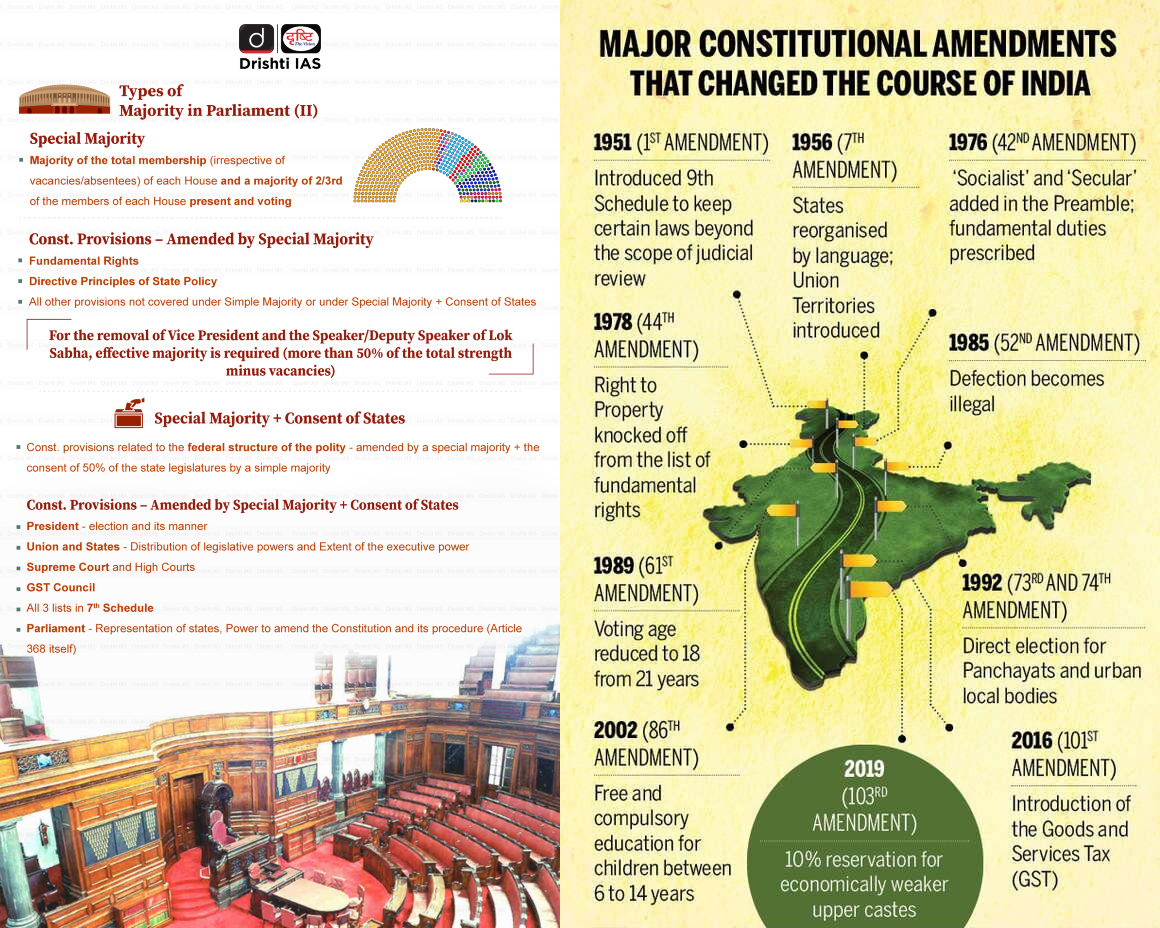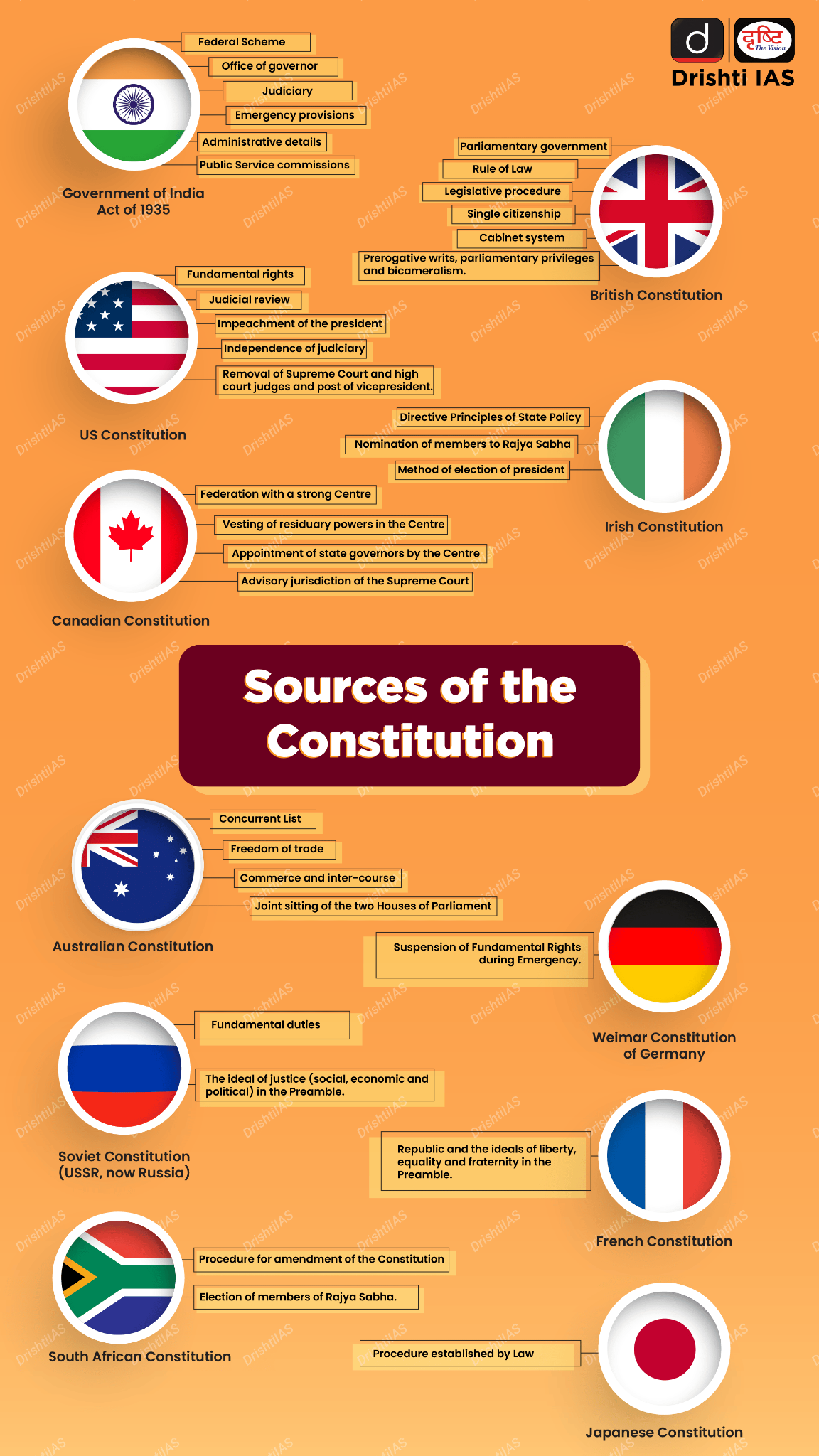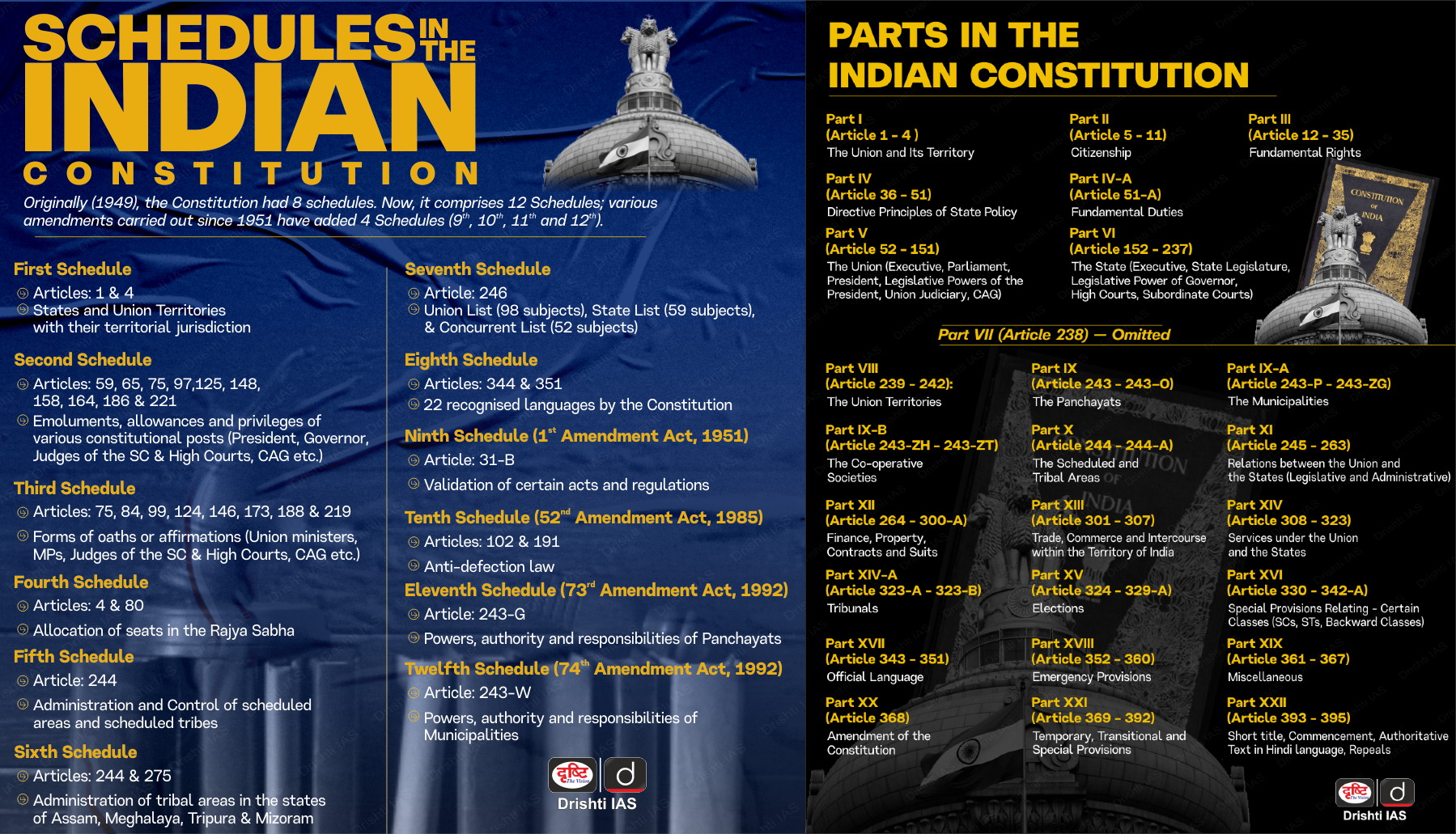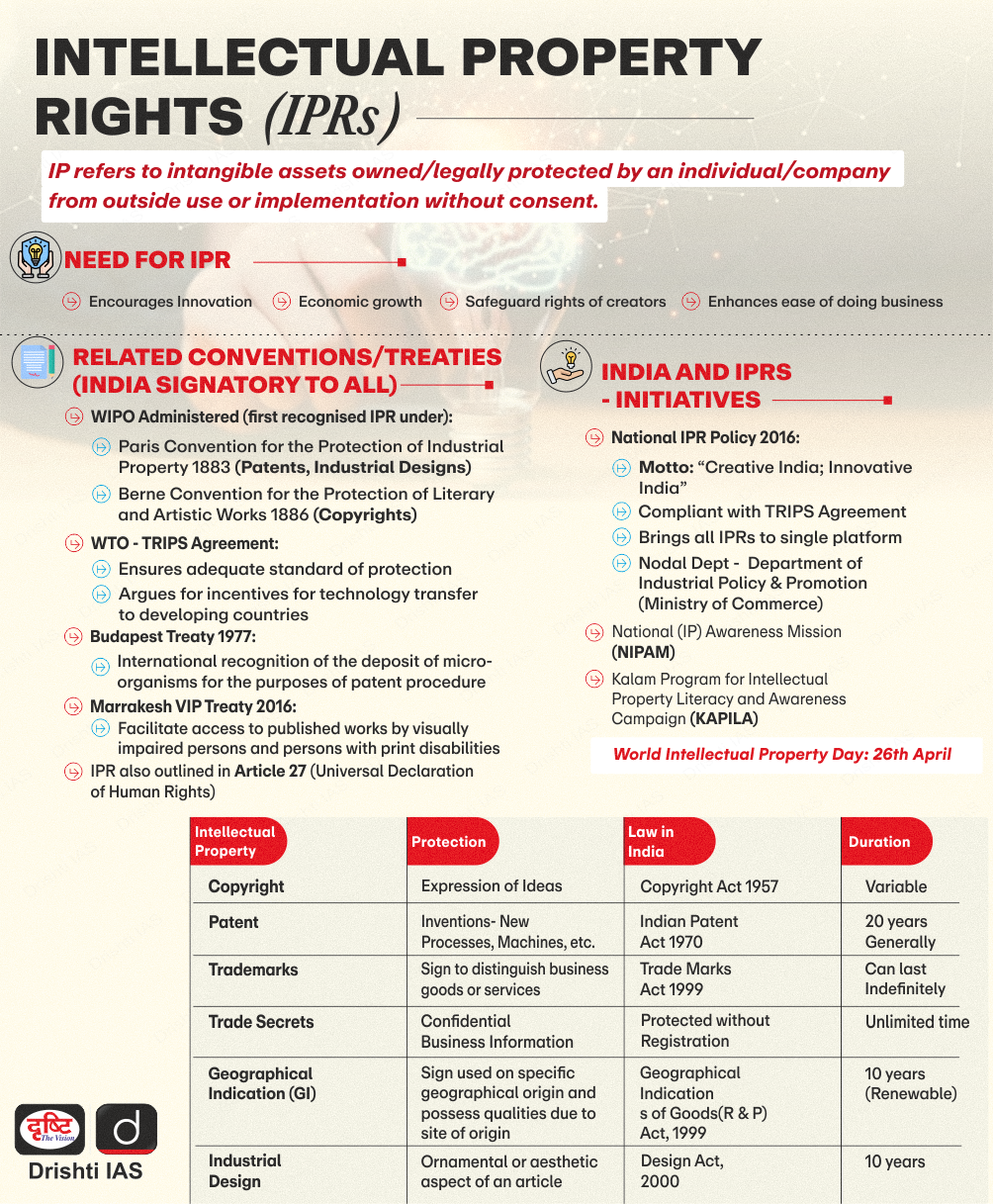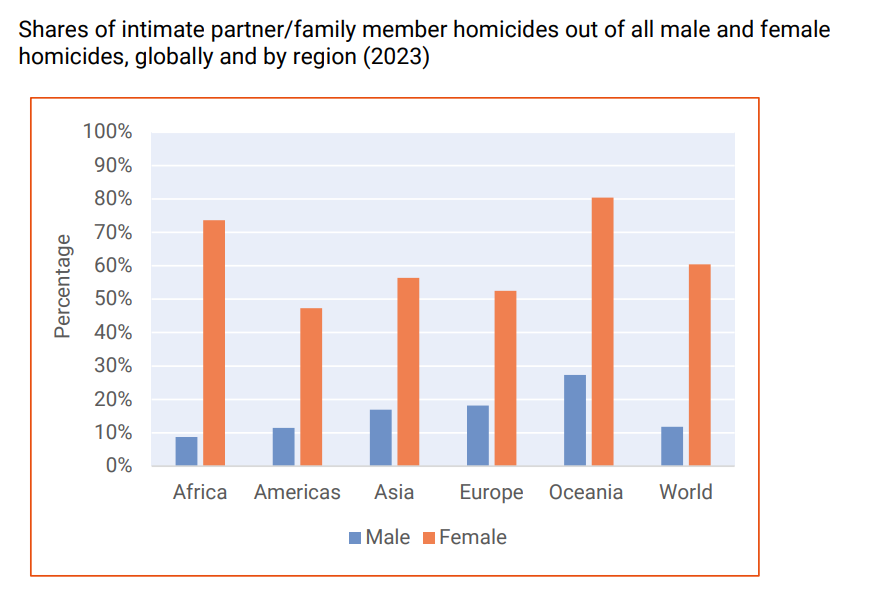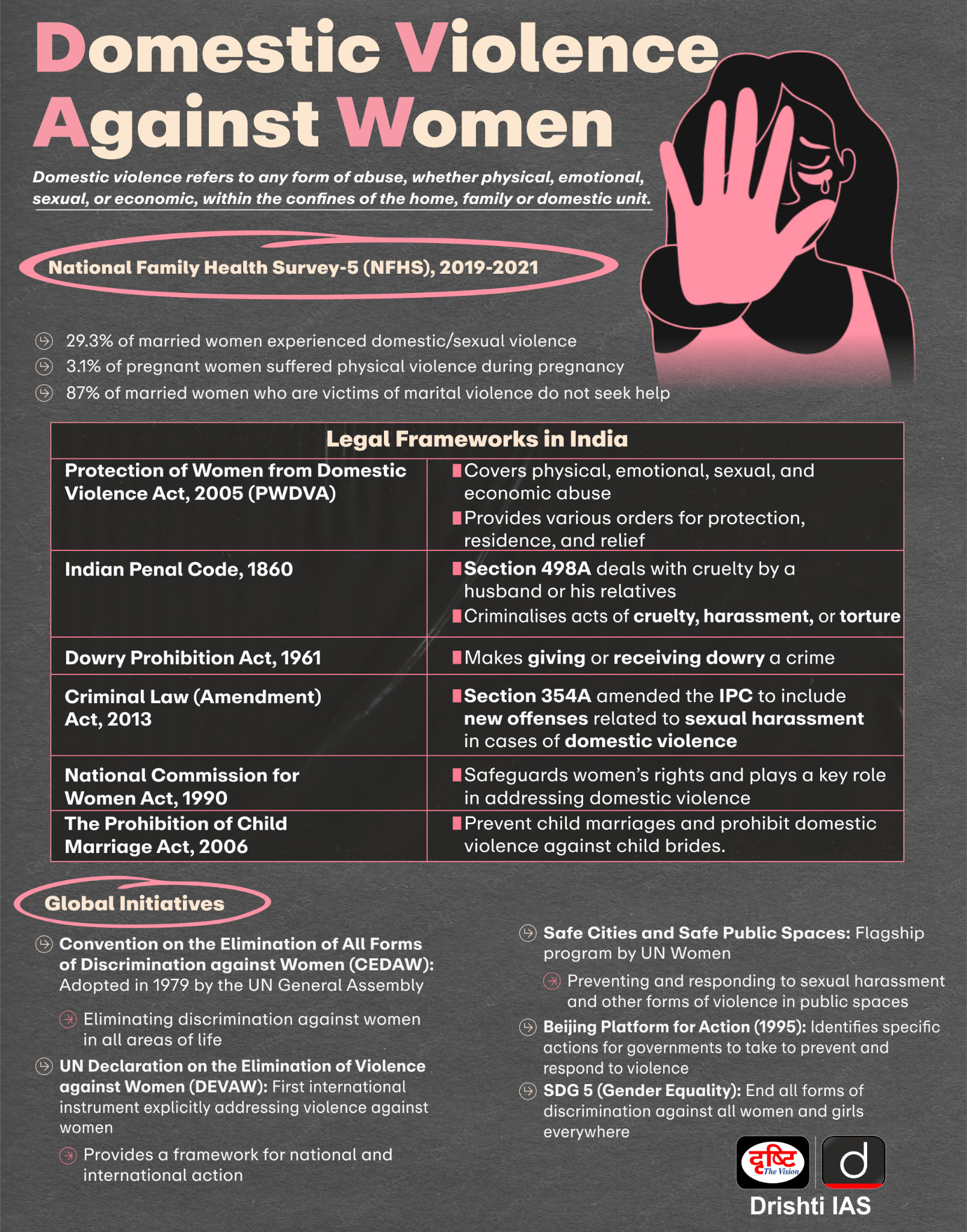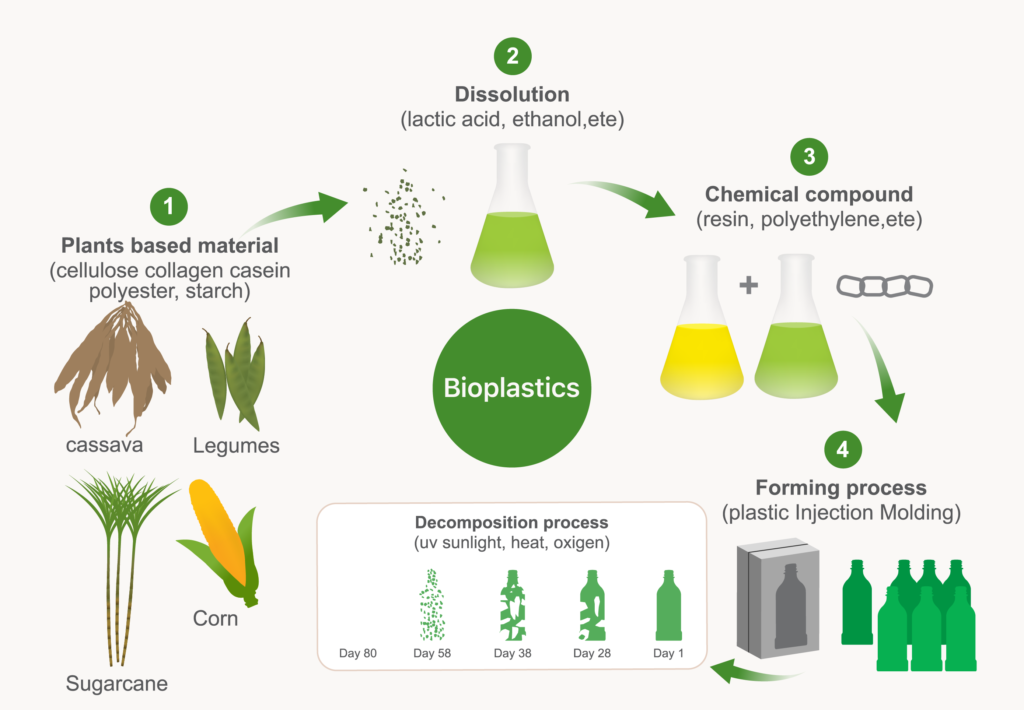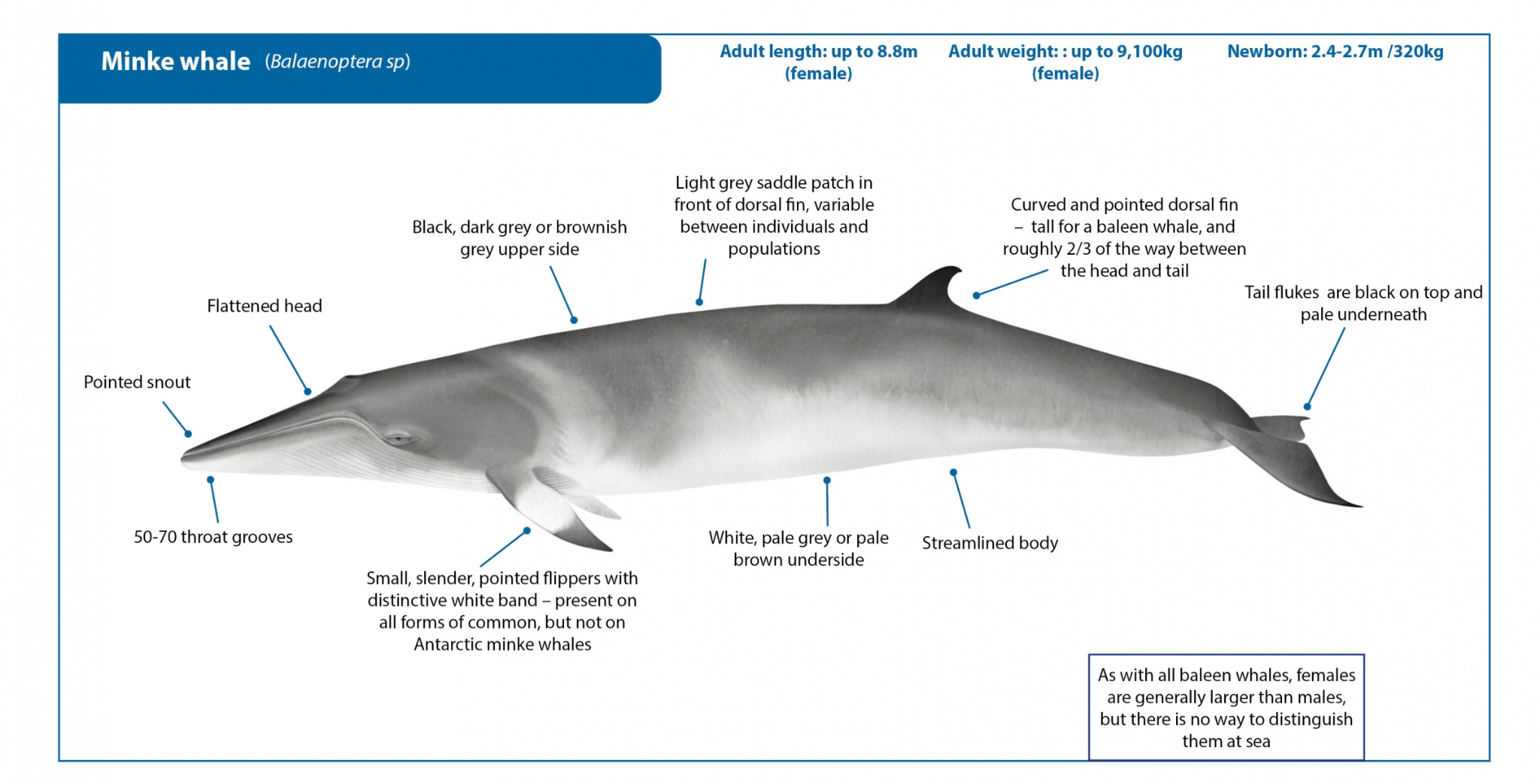Indian Polity
Constitution Day 2024
For Prelims: Constitution Day, Supreme Court of India, 26/11 Mumbai Attacks, Article 370, Sarojini Naidu, Basic Structure of the Constitution, Right to Privacy, Fundamental Right, Directive Principles of State Policy, Preamble
For Mains: Constitution and Its Evolution, Global Influence on the Indian Constitution, Drafting of the Indian Constitution, Key Features of the Constitution of India
Why in News?
On Constitution Day, 26th November 2024, the Prime Minister of India joined celebrations organized by the Supreme Court of India, marking 75 years since the adoption of the Indian Constitution. He emphasized the Constitution as a living document crucial for socio-economic progress and justice.
- The occasion also commemorated the victims of the 26/11 Mumbai attacks, underscoring India’s resilience.
What is Constitution Day?
- About: Constitution Day marks the adoption of the Indian Constitution on 26th November 1949. It celebrates India's democratic values and promotes awareness of justice, liberty, equality, and fraternity.
- In 2015, the Ministry of Social Justice and Empowerment declared 26th November as Constitution Day to deepen citizens' connection with the Constitution. Before 2015, 26th November was observed as National Law Day.
- The day honours the Constituent Assembly's vision in drafting the Constitution and Dr B.R. Ambedkar's pivotal role as Chairman of the Drafting Committee, earning him the title "Father of the Indian Constitution."
- Key Highlights of the Constitution Day 2024:
- Constitution Day Celebrations in Jammu and Kashmir: For the first time in 74 years, Jammu and Kashmir celebrated Constitution Day, following the abrogation of Article 370 in 2019.
- The event symbolized a new chapter in the Union Territory's alignment with India's legal and political framework.
- Hamara Samvidhan, Hamara Samman: The Minister of Labour and Employment participated in the "Hamara Samvidhan, Hamara Samman" campaign.
- The "Hamara Samvidhan, Hamara Samman" campaign, launched on 24th January 2024, aims to deepen citizens' understanding of the Constitution and its role in shaping Indian society.
- This is a year-long initiative promoting constitutional awareness, legal rights, and responsibilities.
- The campaign includes regional events, workshops, and seminars, along with sub-campaigns like Sabko Nyay, Har Ghar Nyay (justice for all), Nav Bharat, Nav Sankalp (new resolve for a new India), and Vidhi Jagriti Abhiyaan (legal awareness).
- The campaign aligns with India’s vision for a developed nation by 2047.
- The "Hamara Samvidhan, Hamara Samman" campaign, launched on 24th January 2024, aims to deepen citizens' understanding of the Constitution and its role in shaping Indian society.
- Women of India's Constituent Assembly: The President of India highlighted the contributions of 15 women members in the Constituent Assembly, including Sarojini Naidu, Sucheta Kripalani, and Vijaya Lakshmi Pandit.
- Lesser-known members like Ammu Swaminathan, Annie Mascarene, Begum Qudsia Aizaz Rasul, and Dakshayani Velayudhan were also recognized for shaping India’s Constitution.
- Ammu Swaminathan: From Kerala, she entered politics after witnessing social restrictions on widows. Advocated for gender equality through the Hindu Code Bill, enduring male-dominated ridicule in the Assembly.
- Annie Mascarene (1902-1963): She campaigned for universal adult franchise against casteist opposition.
- Begum Qudsia Aizaz Rasul (1909-2001): A member of the Muslim League, she opposed religion-based electorates despite complex views on Partition.
- Dakshayani Velayudhan (1912-1978): The first Dalit woman graduate in science and the first Dalit woman in the Cochin Legislative Council. Opposed separate electorates for Dalits, emphasising nationalism.
- Constitution Day Celebrations in Jammu and Kashmir: For the first time in 74 years, Jammu and Kashmir celebrated Constitution Day, following the abrogation of Article 370 in 2019.
What Makes the Indian Constitution a "Living Document"?
- Amendability: The Indian Constitution can be amended to address changing needs and circumstances. This flexibility allows it to evolve over time while maintaining its core principles.
- Provision for Amendments: Article 368 in Part XX grants Parliament the power to amend the Constitution by addition, variation, or repeal of any provision, following the laid-down procedure.
- Parliament cannot amend the 'basic structure' of the Constitution, as ruled in the Kesavananda Bharati vs State of Kerala case, 1973 by the Supreme Court.
- Types of Amendments: Amendments to the Constitution can be made in 3 different ways, by a simple majority of Parliament, by a special majority of Parliament, and special majority + state ratification for some amendments.
- Amendments under the simple majority category do not fall under Article 368.
- Provision for Amendments: Article 368 in Part XX grants Parliament the power to amend the Constitution by addition, variation, or repeal of any provision, following the laid-down procedure.
- Judicial Interpretation: The judiciary, particularly the Supreme Court, plays a crucial role in interpreting the Constitution.
- Landmark judgments and evolving interpretations ensure that the Constitution remains relevant and responsive to contemporary issues.
- Courts have interpreted provisions to meet contemporary needs, such as recognising the Right to Privacy as a Fundamental Right in the K.S. Puttaswamy v. Union of India, 2017
- Federal Structure: The federal structure of the Indian Constitution balance of power between the central and state governments, addressing regional needs and diversity.
- Article 246 outlines three lists in the Seventh Schedule: Union, State, and Concurrent. The Centre legislates on the Union List, states on the State List, and both on the Concurrent List, with Union laws prevailing in case of conflict.
- Hybrid Structure of the Constitution: Certain provisions are rigid, protecting fundamental values like federalism, and secularism.
- Other provisions, such as the Directive Principles of State Policy (DPSP), allow for flexible adaptation to meet the welfare needs of society.
- Responsive to Social Change: The Constitution of India has provisions that allow it to respond to social changes, such as the inclusion of new laws to protect marginalized communities and promote social justice.
- For example, the 89th Amendment Act of 2003 made the National Commission for Scheduled Tribes (NCST) a constitutional body under Article 338A, and the National Commission for Scheduled Castes (NCSC) a separate constitutional body under Article 338, enhancing their roles in creating a more inclusive society
What are the Key Facts about the Constitution of India?
- Constituent Assembly: The Constituent Assembly took nearly three years (2 years, 11 months, 17 days) to draft the Constitution. Initially, it had 389 members, with 292 elected from Provincial Legislative Assemblies, 93 from Princely States, and 4 from Chief Commissioners' Provinces.
- However, following the partition of India in 1947 and the creation of Pakistan, a separate Constituent Assembly was formed for Pakistan, reducing the membership of India’s Assembly to 299.
- Original Structure (1949): Initially, it contained a Preamble, 395 Articles (divided into 22 Parts), and 8 Schedules.
- Current Structure: It now includes a Preamble, more than 450 Articles (divided into 25 Parts), and 12 Schedules.
- Amendments: As of September 2024, there have been 106 amendments of the Constitution of India since it was first enacted in 1950.
- Length: The Constitution of India is the lengthiest written Constitution in the world.
- It was handwritten by Prem Behari Narain Raizada in calligraphy, with pages decorated by artists from Shantiniketan under Nandalal Bose’s guidance.
- Reason for Extensive Size: The vastness and diversity of India have necessitated a detailed constitutional document.
- The influence of the Government of India Act of 1935, which itself was a comprehensive document, has contributed to the Constitution’s size.
- India’s single unified Constitution, which governs both the central and state governments, also added to its size.
- The Constituent Assembly, led by legal experts, crafted a Constitution that is both thorough in legal and administrative aspects, encompassing fundamental governance principles as well as detailed administrative provisions.
- Furthermore, the Constitution draws from various global sources, with provisions inspired by the American, Irish, British, Canadian, Australian, German, and other constitutions, reflecting the broader international influence on its design.
- Criticisms of the Indian Constitution:
| Criticism | Debunking |
| Borrowed Constitution | The framers adapted and modified borrowed features to suit Indian conditions, avoiding their faults. |
| Carbon Copy of the Government of India Act, 1935 | While many provisions were borrowed, the Constitution is not a mere copy. It incorporates significant changes and additions. |
| Un-Indian or Anti-Indian | The Constitution reflects Indian values and aspirations, despite borrowing from foreign sources. |
| Un-Gandhian | While not explicitly Gandhian, the Constitution aligns with many of Gandhi's principles, particularly in the DPSP. |
| Elephantine Size | The Constitution's detailed nature is essential for managing India's diversity and complexity. |
| Paradise of the Lawyers | The legal language is essential for clarity and enforceability. |
|
Drishti Mains Question: The Indian Constitution is often referred to as a 'living document.' Analyse its ability to adapt to changing circumstances. |
UPSC Civil Services Examination, Previous Year Questions (PYQs)
Prelims
Q. What was the exact constitutional status of India on 26th January, 1950? (2021)
(a) A Democratic Republic
(b) A Sovereign Democratic Republic
(c) A Sovereign Secular Democratic Republic
(d) A Sovereign Socialist Secular Democratic Republic
Ans: (b)
Q) Who among the following was the chairman of the Union Constitution Committee of the Constituent Assembly? (2005)
(a) B.R. Ambedkar
(b) J. B. Kripalani
(c) Jawaharlal Nehru
(d) Alladi Krishnaswami Ayyar
Ans: (c)
Q. The distribution of powers between the Centre and the States in the Indian Constitution is based on the scheme provided in the (2012)
(a) Morley-Minto Reforms, 1909
(b) Montagu-Chelmsford Act, 1919
(c) Government of India Act, 1935
(d) Indian Independence Act, 1947
Ans: (c)
Mains
Q. It would have been difficult for the Constituent Assembly to complete its historic task of drafting the Constitution for Independent India in just three years but for the experience gained with the Government of India Act, 1935. Discuss. (2015)
Q. Examine the scope of Fundamental Rights in the light of the latest judgement of the Supreme Court on Right to Privacy. (2017)
Q: Though the federal principle is dominant in our constitution and that principle is one of its basic features, but it is equally true that federalism under the Indian Constitution leans in favour of a strong Center, a feature that militates against the concept of strong federalism. Discuss. (2014)


Governance
Design Law Treaty (DLT)
For Prelims: World Intellectual Property Organization (WIPO), Design Law Treaty (DLT), Industrial Designs, Intellectual Property, Designs Act, 2000, TRIPS Agreement, Trademark, Copyright Act, 1957.
For Mains: Safeguarding Intellectual Property Rights.
Why in News?
Recently, the member states of the World Intellectual Property Organization (WIPO) including India adopted the Design Law Treaty (DLT) at the Diplomatic Conference to Conclude and Adopt the Design Law Treaty held in Riyadh, Saudi Arabia.
State of India's Intellectual Property
- India’s Innovation Ranking: WIPO’s Global Innovation Index (GII) 2024 ranked India 39th among the 133 economies featured in the GII 2024.
- India ranked 1st among the 10 economies in Central and Southern Asia.
- India’s Global IP Ranking: India ranks in the global top 10 for all three major intellectual property rights—patents, trademarks, and industrial designs.
- India ranks sixth globally with 64,480 patent applications in 2023.
- India’s trademark office holds the second-largest number of active registrations worldwide with over 3.2 million trademarks in force.
- India’s industrial design applications grew by 36.4% in 2023.
- Increase in IP Activity: India’s patent-to-GDP ratio grew from 144 to 381 in the past decade, indicating an expansion of IP activity in line with economic growth.
- Patent-to-GDP ratio is a measure of the economic impact of patent activity.
What is the Design Law Treaty (DLT)?
- About: DLT is proposed as a comprehensive framework to streamline and facilitate the protection of industrial designs worldwide.
- Objective: Its objective is to create a predictable and accessible system that eliminates unnecessary bureaucratic hurdles and offers greater ease for designers to protect their intellectual property.
- Key Provisions:
- Streamlining Design Application Procedures:
- Clear Application Requirements: Establishes uniform, clear guidelines for all design applications.
- Flexibility in Representation: Applicants can use various formats (drawings, photos, videos) to represent the design to industrial property offices.
- Multiple Use: Allows multiple designs in one application, preserving the original filing date even if some are not accepted.
- Improving the Filing Process:
- Filing Date Simplicity: Applicants can secure a filing date by submitting essential parts initially, with the complete application processed later.
- Grace Period for Public Disclosure: A six or 12-month grace period protects the novelty of designs disclosed before filing.
- Post-Registration Procedure and Protection:
- Publication Control: Applicants can control publication for six months post-filing, ensuring confidentiality and competitive advantage.
- Relief Measures for Missed Deadlines: Relief will be provided for applicants who miss deadlines, preventing loss of rights.
- Clear Post-Grant Transactions: Post-registration procedures (e.g., transfers, licensing) will be clearly defined for easier management and enforcement.
- Two-Tier Structure: The Treaty will consist of articles (the main provisions of the Treaty) and rules (the regulations governing implementation).
- The Assembly of Contracting Parties can amend the rules to adapt to changes in design law and technology.
- Streamlining Design Application Procedures:
What is Industrial Design?
- About: An industrial design is an original creation of an ornamental nature, which, when incorporated in or applied to a product, lends a special appearance to it.
- These characteristics may result from its shape, lines, outline, configuration, colour, texture or material.
- A design may be three-dimensional, such as the shape of a product, or two-dimensional, as in a specific surface pattern.
- It is an Intellectual property (IP) which are intangible creations of the human mind that have value but are not physical objects.
- Application: Designs are applied to a wide range of products, such as packaging, furniture, clothing, electronic devices, medical equipment, handicraft items, and jewelry.
- Importance: Designs are business assets that may increase a product’s market value and provide a competitive advantage.
- By making products attractive to consumers, designs drive consumer choices.
- Protection: Designers need to follow the filing procedures set by the intellectual property (IP) office of the country in which they seek protection.
- Design rights are territorial i.e., the rights arising from protection obtained in one country (or region) are limited to that country (or region).
- The registration and protection of industrial designs in India is administered by the Designs Act, 2000.
- Industrial Design In India: Between 2014-24, design registrations in India have tripled, with domestic filings increasing by 120% in the last two years alone.
- Notably, design applications grew by 25% in 2023.
World Intellectual Property Organisation (WIPO)
- About: WIPO is an specialised agency of the United Nations which was created in 1967 to encourage creative activity, to promote the protection of intellectual property throughout the world.
- Role: Provides services for protecting IP, offers a forum for IP-related issues, and supplies data and information to guide global decision-making.
- Membership: It has 193 member states. India joined WIPO in 1975.
What are Protection Provisions under the Design Act, 2000?
- Eligibility: Designs are protected if they are aesthetic in nature and applied to articles.
- Protection only applies to the appearance of an article, not its functional aspects.
- Designs must be registered with the Design Registry to receive protection.
- Requirements for Protection:
- Novelty and Originality: Design must be new and significantly different from existing designs.
- Non-Disclosure: Design should not have been publicly disclosed in India or abroad.
- Not Functional: Designs driven by functionality are not protected.
- Not Offensive: Designs should not conflict with public morals, security, or integrity.
- Duration of Protection: Protection lasts for at least 10 years under the TRIPS Agreement which can be extended for an additional 5 years through a renewal application.
- Infringement and Enforcement: Registered design owners can prevent others from making, selling, or importing products that copy or imitate their design.
- Excluded Designs from Protection: Certain items like stamps, calendars, books, flags, and layout designs of integrated circuits are excluded from industrial design protection.
- Design cannot include a trademark, property mark, or any artistic rights as defined under the Copyright Act, 1957.
Judgements of Industrial Design
- Ritika Private Limited v. Biba Apparels Private Limited Case, 2016: Ritika, a boutique apparel designer, sued Biba for reproducing and selling garments in the Delhi high court that duplicated Ritika's designs, despite the designs not being registered under the Design Act, 2000.
- The court ruled that the designs were not registered under the Design Act, 2000, and thus, there was no infringement, reinforcing the importance of design registration for protection against duplication and copying.
- Crocs Inc. USA v. Bata India Ltd. and Ors. Case, 2019: Crocs Inc USA filed a design infringement suit against various Indian footwear manufacturers in the Delhi high court. The alleged design referred to perforated and non-perforated shoe design.
- The court held that Crocs Inc USA cannot allege infringement or piracy since the alleged design lacks novelty and originality because of the prior publication of the design in various mediums.
Conclusion
The Design Law Treaty (DLT) aims to simplify the global protection of industrial designs, making it easier and more accessible for designers to safeguard their intellectual property. It ensures a streamlined process, with provisions for multiple designs, grace periods, and clear post-registration procedures, enhancing international design protection.
|
Drishti Mains Question: What is Industrial Design? How the newly adopted Design Law Treaty (DLT) aims to protect it. |
UPSC Civil Services Examination, Previous Year Questions (PYQs)
Prelims
Q. Consider the following statements: (2019)
- According to the Indian Patents Act, a biological process to create a seed can be patented in India.
- In India, there is no Intellectual Property Appellate Board.
- Plant varieties are not eligible to be patented in India.
Which of the statements given above is/are correct?
(a) 1 and 3 only
(b) 2 and 3 only
(c) 3 only
(d) 1, 2 and 3
Ans: (c)
Q.With reference to the ‘National Intellectual Property Rights Policy’, consider the following statements:(2017)
- It reiterates India’s commitment to the Doha Development Agenda and the TRIPS Agreement.
- Department of Industrial Policy and Promotion is the nodal agency for regulating intellectual property rights in India.
Which of the above statements is/are correct?
(a) 1 only
(b) 2 only
(c) Both 1 and 2
(d) Neither 1 nor 2
Ans: (c)
Mains
Q. In a globalized world, Intellectual Property Rights assume significance and are a source of litigation. Broadly distinguish between the terms—Copyrights, Patents and Trade Secrets. (2014)


Social Justice
Femicides in 2023: Global Estimates of Intimate Partner/Family Member Femicides Report
For Prelims: International Day for the Elimination of Violence against Women, UN Women, United Nations Office on Drugs and Crime (UNODC), National Crime Records Bureau 2022, United Nations General Assembly.
For Mains: Issues Related to women, Role of societal norms and women empowerment
Why in News?
Recently, the Femicides in 2023: Global Estimates of Intimate Partner/Family Member Femicides report was on the International Day for the Elimination of Violence against Women (25th November).
- It was released by UN Women and the United Nations Office on Drugs and Crime (UNODC) highlighting the severity of the global crisis of femicide.
- Femicide is defined as an intentional killing with a gender-related motivation. It is driven by discrimination against women and girls, unequal power relations, gender stereotypes or harmful social norms.
- It is different from homicide, where the motivation may not be gender-related.
What are the Key Findings of the Report?
- Global Scenario: In 2023, 85,000 women and girls were intentionally killed worldwide, with 60% (approximately 51,100) killed by intimate partners or family members.
- On average, 140 women and girls per day were victims of femicide by intimate partners or close relatives.
- Regional Disparities: Africa reported the highest number of victims (21,700) and the highest rate of femicide per population (2.9 per 100,000).
- The Americas and Oceania followed, with rates of 1.6 and 1.5 per 100,000, respectively, while Asia and Europe reported significantly lower rates, at 0.8 and 0.6 per 100,000.
- Non-Domestic Femicide: Non-domestic femicides are increasingly recognised. For instance, 5% of femicides in France (2019–2022) and 9% in South Africa (2020–2021) occurred outside domestic settings.
- Male as Homicide Victims: An estimated 80% of all homicide victims in 2023 were men while 20% were women.
- But, lethal violence impacts women more than men, with nearly 60% of women intentionally killed in 2023 being victims of intimate partner or family member homicide.
- Preventability of Femicide: A significant number of women killed by intimate partners had previously reported violence, including 22–37% in France (2019–2022) and similar trends in South Africa (2020–2021).
- Data and Availability: Data availability has declined, with only half as many countries reporting in 2023 as in 2020 (75 countries in 2020).
- Only a few countries collect data on non-domestic femicides using the UNODC-UN Women framework.
What are the Forms of Violence Against Women?
- Domestic Violence: It involves actions by a current or former partner, often a husband, or family members that cause physical, sexual, or emotional harm.
- Examples include physical aggression, coercion, psychological abuse, and controlling behaviours.
- Sexual Violence: It involves unwanted sexual acts imposed without consent, disproportionately targeting women and girls.
- Examples include rape, sexual harassment, online sexual abuse, non-contact sexual abuse, trafficking, and forced prostitution.
- In India, over 31,000 rape cases were reported in 2022, amounting to nearly 87 cases daily, as per the National Crime Records Bureau 2022.
- Psychological Abuse: It involves intimidation through looks, gestures, or shouting, as well as humiliation, obscene or derogatory comments, and public ridicule.
- It also includes practices like isolating menstruating women and female infanticide, which violate women’s rights and dignity.
- Cultural Abuse: It includes harmful social and cultural practices like female genital mutilation, witch-branding, child marriage, forced marriage, honour-based violence, and widowhood rituals.
- Technology-Facilitated Violence: It involves online defaming, harassment, stalking, cyberbullying, distribution of morphed and deepfake videos, and doxing (the release of private information about a woman publicly).
What are Key Facts Regarding Gender Violence in India?
- Increase in Crimes Against Women: According to the National Crime Records Bureau (NCRB) 2022 data, crimes against women rose 4% in 2022 compared to 2021.
- Nature of Crimes Against Women: The majority of crimes against women in 2022 were:
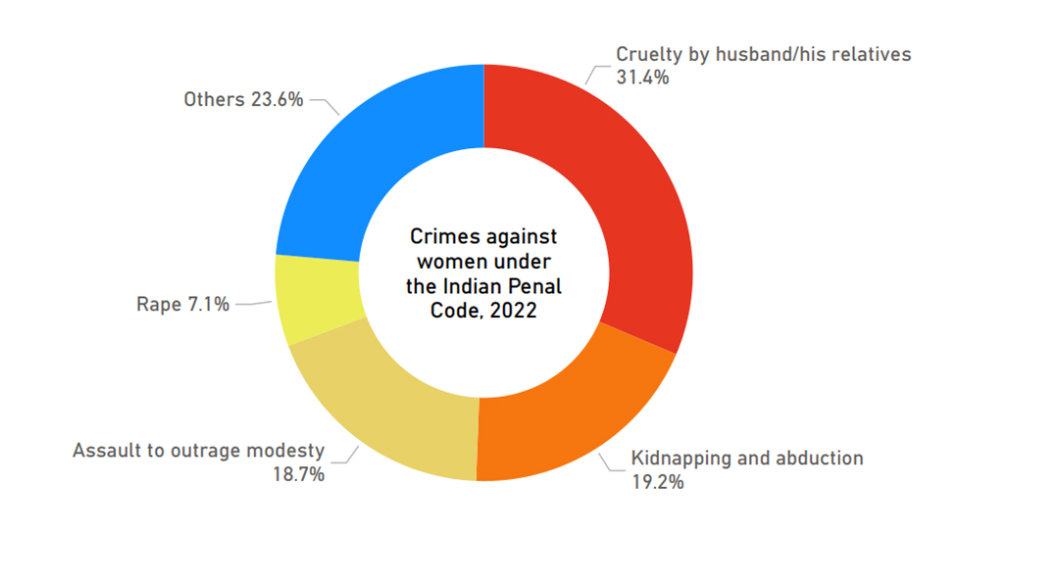
- Additionally, 13,479 cases were registered under the Dowry Prohibition Act, 1961
- Filing of FIRs: The NCRB’s report reveals that over 4.45 lakh cases of crimes against women were registered in 2022, equivalent to nearly 51 FIRs (first information report) every hour.
- High Rape Cases: There were more than 31,000 reported rapes in 2022. Rapes peaked at nearly 39,000 in 2016.
- In 2018, on average one woman reported a rape every 15 minutes across the country.
International Day for the Elimination of Violence Against Women
- About: It is observed on 25th November to raise awareness against violence against women and girls (VAWG).
- It was designated by the United Nations General Assembly in 1999.
- Honouring the Mirabal Sisters: The date honours the Mirabal Sisters (Patria, Minerva, and María Teresa) of the Dominican Republic, symbols of resistance against Rafael Trujillo's dictatorship and violence.
- On 25th November 1960, the sisters were assassinated by Trujillo’s orders.
United Nations Office on Drugs and Crime (UNODC)
- About: Founded in 1997, UNODC is a global leader in combating illicit drugs, international crime, and terrorism.
- Headquarters: It is located in Vienna with liaison offices in New York and Brussels.
- Terrorism Prevention: Expanded its activities in 2002 to assist states in ratifying and implementing universal legal instruments against terrorism.
UN Women
- About: UN Women is the UN entity aiming to address global gender inequality and empower women and girls.
- Creation: Established in July 2010 by the United Nations General Assembly as part of the UN reform agenda. It merged four existing UN entities.
- Division for the Advancement of Women (DAW)
- International Research and Training Institute for the Advancement of Women (INSTRAW)
- Office of the Special Adviser on Gender Issues and Advancement of Women (OSAGI)
- United Nations Development Fund for Women (UNIFEM)
- Key Goals: Eliminate discrimination against women and girls.
- Empower women and achieve equality between women and men.
- Promote gender equality in development, human rights, peace, and security.
What are the key Laws for Women’s Safety in India?
How to Prevent Femicide as per the Report?
- Addressing Root Causes: Focus on the root causes of gender-based violence at multiple levels.
- Individual Level: Address attitudes, behaviours, and histories of violence.
- Interpersonal Relationships: Improve family dynamics and partner interactions.
- Community Level: Strengthen organisational and community-based support systems.
- Societal Level: Challenge entrenched gender norms and stereotypes.
- Educational Initiatives: Integrate curricula to promote gender equality, relationship skills, and acceptable societal roles for men and women.
- Engage both genders in rethinking attitudes and behaviors that perpetuate violence.
- Legal Measures: Classify femicide as a distinct criminal offense, as done in Latin America, by adding aggravating factors for homicides driven by gender-based motives.
- Establish dedicated units within police, judiciary, and prosecution services for handling gender-based violence (e.g., Canada, Sweden, Jordan).
- Risk Reduction: Train police to identify high-risk situations and intervene promptly.
- Enforce orders preventing contact between perpetrators and victims and limit firearm access for individuals with histories of intimate partner violence to reduce the odds of killings.
- Awareness Movements: Campaigns like #MeToo and Ni Una Menos (Not one [woman] less in Argentina) to bring public attention to gender-based violence and condemn harmful practices.
- Data Collection and Analysis: Governments should produce annual reports on femicide trends and patterns.
- Civil Society should establish "femicide observatories" to monitor and analyse data from multiple sources.
Conclusion
The report highlights the global crisis of femicide, urging a multifaceted approach to combat gender-based violence. Prevention requires addressing root causes, strengthening legal frameworks, increasing public awareness, and improving data collection. Collective action across individual, societal, and institutional levels is essential to curb femicide and protect women's rights.
|
Drishti Mains Question: Examine the root causes of gender-based violence and propose strategies to prevent femicide in India. |
UPSC Civil Services Examination, Previous Year Questions (PYQs)
Prelims
Q. ‘Beijing Declaration and Platform for Action’, often seen in the news, is (2015)
(a) a strategy to tackle the regional terrorism, an outcome of a meeting of the Shanghai Cooperation Organization
(b) a plan of action for sustainable economic growth in the Asia-Pacific Region, an outcome of the deliberations of the Asia-Pacific Economic Forum
(c) an agenda for women’s empowerment, an outcome of a World Conference convened by the United Nations
(d) a strategy to combat wildlife trafficking, a declaration of the East Asia Summit
Ans: (c)
Mains
Q. We are witnessing increasing instances of sexual violence against women in the country. Despite existing legal provisions against it, the number of such incidences is on the rise. Suggest some innovative measures to tackle this menace. (2014)
Q. Male membership needs to be encouraged in order to make women’s organization free from gender bias. (2013)


Indian Economy
State of the Rural Economy of India
For Prelims: India's rural economy, Pradhan Mantri Krishi Sinchayee Yojana, Pradhan Mantri Gram Sadak Yojana, BharatNet, Common Service Centers, Deendayal Upadhyaya Gram Jyoti Yojana (DDUGJY), BharatNet Project, MUDRA, SFURTI, Start-up India, Pradhan Mantri Kaushal Vikas Yojana (PMKVY), Smart Cities Mission, AMRUT, Rurban Mission, eNAM, Production Linked Incentive (PLI) Scheme
For Mains: State of Rural Economy, Initiatives for Promoting Rural Manufacturing, Challenges and Way Forward for Rural Manufacturing, Role of Women-owned Non-Agricultural Enterprises in Rural Economy, Current Major Challenges Related to Rural India.
Why in News?
India's rural economy faces significant challenges, including poverty, unemployment, and agrarian distress. To address these issues, there is a need to focus on rural industrialisation, particularly through women-owned non-agricultural enterprises.
- Expanding such enterprises can enhance GDP growth and improve employment opportunities in rural areas, especially for women.
What is the State of India's Rural Economy?
- Rural Demographics:
- According to Census 2011, 68.85% of India’s population resides in rural areas and it is projected by NITI Aayog that it will remain above 50% even in 2045, indicating the sustained significance of rural India in the nation's socio-economic fabric.
- Living Conditions:
- According to Census 2011, around 39% of rural households resided in one-room accommodations, with only 53.2% having access to electricity compared to 92.7% in urban areas.
- Traditional fuels like firewood were used for cooking by 86% of rural households, and only 30.8% had access to tap water, highlighting challenges in basic infrastructure and amenities.
- Rural Poverty:
- The Tendulkar methodology shows rural poverty was alarmingly high at 41.8% in 2004–05, declining to around 25% in 2011–12.
- However, 6 states still had poverty ratios exceeding 35% in 2011–12.
- The rural Monthly Per Capita Consumption Expenditure (MPCE) remains significantly lower than urban levels, indicating limited consumption capacity and acute poverty.
- The Tendulkar methodology shows rural poverty was alarmingly high at 41.8% in 2004–05, declining to around 25% in 2011–12.
- Employment:
- The PLFS Report 2023-24 highlights that rural employment is largely characterised by self-employment (53.5%) and casual labour (25.6%).
- A significant portion of rural workers (58.4%) is engaged in agriculture (offers seasonal employment).
- Salaried jobs in rural areas comprise only 12% of the workforce, with most of these positions lacking contracts, paid leave, and job security.
- The India Employment Report 2024 by the ILO shows unemployment among educated youth has nearly doubled from 35.2% in 2000 to 65.7% in 2022, with women (76.7%) facing higher unemployment than men (62.2%).
- From 2017–18 to 2023–24, India added 150 million jobs, with rural women driving 54% of this growth, particularly in agriculture.
- Rural female workforce participation increased by 12.5% to 34.8% in 2023–24.
- The PLFS Report 2023-24 highlights that rural employment is largely characterised by self-employment (53.5%) and casual labour (25.6%).
- Agricultural Distress:
- Small and marginal farmers, who constitute 86% of the farming population, hold only 43% of agricultural land, while larger farmers with economic holdings manage 53% of the land .
- Agricultural labourers who make up a larger proportion of the rural workforce compared to landowners face seasonal work, low wages, and a lack of social security measures, including medical assistance and pensions.
What Steps Have Been Taken to Promote Rural Economy in India?
- Infrastructure Development:
- Pradhan Mantri Gram Sadak Yojana (PMGSY),
- BharatNet Project
- Deendayal Upadhyaya Gram Jyoti Yojana (DDUGJY) has played a pivotal role in rural electrification, bringing electricity to over 18,000 villages and boosting economic activities.
- Support for MSMEs:
- Promoting Rural Entrepreneurship and Employment:
- Strengthening Rural-Urban Linkages:
- Policy Frameworks for Rural Manufacturing:
What are the Challenges to Rural Economy in India?
- Stagnation of the Manufacturing Sector: India’s manufacturing sector has experienced stagnation, contributing only 15% to the GDP in 2023, down from 16.1% in 2014-15.
- Spatial Planning Challenge: India's shift from agriculture to manufacturing has been slow and uneven, with over 40% of the workforce still employed in agriculture, compared to 20% in China and 2% in the US.
- Infrastructural Issues: De-urbanisation of manufacturing in India has shifted organised manufacturing from urban to rural areas, reducing costs but hindering growth due to inadequate rural infrastructure.
- Small towns and rural areas are emerging as engines of economic growth in India, with over half of the urban population residing in these regions, projected to grow significantly by 2050.
- Investment Challenges: Private investment in rural manufacturing is limited. Factors such as poor physical infrastructure, lack of reliable land records, and distorted capital markets contribute to this underinvestment.
- The absence of efficient resource allocation mechanisms has restricted the entry of new, more efficient enterprises.
What Measures Can Be Taken to Boost Rural Economic Growth in India?
- Infrastructure Investments: Significant investments in rural infrastructure, including roads, electricity, and telecommunications, are vital for creating a conducive environment for manufacturing growth and economic development.
- Promoting MSMEs: Policies should focus on empowering micro, small, and medium enterprises (MSMEs) by ensuring easier access to credit, land, and skill development programs.
- Supporting MSMEs, especially those addressing rural demands, will enhance entrepreneurship and generate employment.
- A policy shift towards developing small towns as industrial hubs is crucial for balanced regional development and mitigating urban-rural disparities.
- Focus on Skill Development: Skill development programs must be aligned with industry needs to boost the employability of the rural workforce, particularly in non-agricultural sectors.
- It will ensure they are ready for the opportunities arising from rural industrialization.
- Promoting Women-Owned Non-Agricultural Enterprises: These enterprises contribute to economic growth by enhancing productivity, diversifying incomes, and promoting financial inclusion.
- Women need to account for over half the new jobs created by 2030 for India to achieve an 8% GDP growth rate.
- Formalising these enterprises, and providing targeted business and financial support through priority sector lending, is crucial.
- Enhancing Digital Infrastructure: Expanding digital infrastructure, including internet access and mobile connectivity in rural areas will facilitate women's participation in non-agricultural sectors.
- This would enable women to leverage fintech solutions for better financial access and efficient business management.
|
Drishti Mains Question: Discuss the state of India's rural economy and propose measures to address the challenges faced by the rural economy. |
UPSC Civil Services Examination Previous Year Question (PYQ)
Prelims
Q1. Which of the following grants/grant direct credit assistance to rural households? (2013)
- Regional Rural Banks
- National Bank for Agriculture and Rural Development
- Land Development Banks
Select the correct answer using the codes given below:
(a) 1 and 2 only
(b) 2 only
(c) 1 and 3 only
(d) 1, 2 and 3
Ans: (c)
Q2. How does the National Rural Livelihood Mission seek to improve livelihood options of rural poor? (2012)
- By setting up a large number of new manufacturing industries and agribusiness centres in rural areas
- By strengthening ‘self-help groups’ and providing skill development
- By supplying seeds, fertilisers, diesel pump-sets and micro-irrigation equipment free of cost to farmers
Select the correct answer using the codes given below:
(a) 1 and 2 only
(b) 2 only
(c) 1 and 3 only
(d) 1, 2 and 3
Ans: (b)


Important Facts For Prelims
Basic Animal Husbandry Statistics 2024
Why in News?
Recently, the Ministry of Fisheries, Animal Husbandry & Dairying released the Basic Animal Husbandry Statistics 2024 (BAHS) on the occasion of National Milk Day (26th November).
- It is based on the outcomes of the Integrated Sample Survey (ISS) (March 2023–February 2024) and shows trends in major livestock products like milk, eggs, meat, and wool.
- ISS is an annual, large-scale survey conducted by the Department of Animal Husbandry and Dairying.
- It covers 15% of the villages across the country and estimates livestock numbers and production data for major products, including milk, meat, wool, and eggs.
Note:
National Milk Day is celebrated on the birth anniversary of Verghese Kurien who made India self-sufficient in milk output through the white revolution.
What are Key Highlights of the BAHS 2024?
- Milk Production: India’s total milk production for 2023-24 is estimated at 239.30 million tonnes, reflecting a 3.78% increase over 2022-23.
- India is the largest producer of milk in the world. Top 3 producers are Uttar Pradesh, Rajasthan and Madhya Pradesh.
- Per Capita Milk Availability increased to 471 grams per day in 2023-24 from 459 grams per day in 2022-23.
- Egg Production: Total egg production for 2023-24 is estimated at 142.77 billion numbers, a 3.18% increase from 2022-23.
- India ranked 2nd globally in egg production. Top 3 producers are Andhra Pradesh, Tamil Nadu, and Telangana.
- Meat Production: India’s total meat production for 2023-24 is estimated at 10.25 million tonnes, reflecting a 4.95% growth over 2022-23.
- Top 3 producers are West Bengal, Uttar Pradesh, and Maharashtra.
- Wool Production: India’s total wool production for 2023-24 is estimated at 33.69 million kg, showing a 0.22% increase from the previous year.
- Top 3 producers are Rajasthan, Jammu & Kashmir, and Gujarat.
- Livestock Growth: From 2014-15 to 2022-23, the sector grew at a compound annual growth rate (CAGR) of 7.38% (at constant prices).
- The share of livestock in agriculture Gross Value Added (GVA) increased from 24.32% (2014-15) to 30.38% (2022-23).
- Currently, the 21st Livestock Census is underway to provide updated data on cattle populations.
21st Livestock Census
- About: The 21st Livestock Census was recently launched by the Ministry of Fisheries, Animal Husbandry and Dairying.
- The census is carried out every five years to gather data on the number of domesticated animals, poultry, and stray animals across the country.
- A total of 20 livestock censuses have been conducted since 1919. The 20th Census was conducted in 2019.
- Data Collection: The data will include information about the species, breed, age, sex, and ownership status of animals.
- Animals Included in the Census:
- Animals: The census will cover 16 animal species, including Cattle, buffalo, mithun, yak, sheep, goat, pig, camel, horse, ponies, mule, donkey, dog, rabbit, and elephant.
- 219 indigenous breeds recognised by the ICAR-National Bureau of Animal Genetic Resources (NBAGR) will be included.
- Poultry Birds: The census will also count poultry birds, including Fowl, chicken, duck, turkey, geese, quail, ostrich, and emu.
- Animals: The census will cover 16 animal species, including Cattle, buffalo, mithun, yak, sheep, goat, pig, camel, horse, ponies, mule, donkey, dog, rabbit, and elephant.
UPSC Civil Services Examination, Previous Year Questions (PYQs)
Prelims
Q. As per the NSSO 70th Round “Situation Assessment Survey of Agricultural Households”, consider the following statements: (2018)
- Rajasthan has the highest percentage share of agricultural households among its rural households.
- Out of the total agricultural households in the country, a little over 60 percent belong to OBCs.
- In Kerala, a little over 60 percent of agricultural households reported to have received maximum income from sources other than agricultural activities.
Which of the statements given above is/are correct?
(a) 2 and 3 only
(b) 2 only
(c) 1 and 3 only
(d) 1, 2 and 3
Ans: (c)


Important Facts For Prelims
Bioplastics
Why in News?
In February 2024, Balrampur Chini Mills, Uttar Pradesh one of India's leading sugar producers, announced a Rs 2,000 crore investment in India's first bioplastics factory to produce Bioplastics.
- This project is expected to play a pivotal role in diversifying the sugar industry and contributing to environmental sustainability by introducing biodegradable alternatives to petroleum-based plastics.
What are Bioplastics?
- About: Bioplastics are derived from renewable organic sources like sugarcane, corn, unlike traditional plastics made from petroleum. They are not always biodegradable or compostable.
- Bioplastics are produced by extracting sugar from plants like corn and sugarcane and converting it into polylactic acids (PLAs). Alternatively, they can be made from polyhydroxyalkanoates (PHAs) from microorganisms which are then polymerized into bioplastic.
- Advantages of Bioplastics: For sugar companies, bioplastics offer a new revenue stream beyond traditional sugar production and ethanol. The bioplastics project is expected to generate Rs 1,700 crore to Rs 1,800 crore annually.
- The production of Bioplastics absorbs carbon dioxide (CO2) and contributes to a neutral or potentially negative carbon balance, helping reduce the carbon footprint compared to fossil-based plastics.
- Unlike traditional plastics, bioplastics do not contain harmful chemicals such as phthalates, which are known to be hazardous to human health.
- Bioplastics are as strong and durable as traditional plastics, making them ideal for use in a variety of applications such as food packaging, agricultural films, and medical supplies.
- The use of renewable resources for bioplastic production helps reduce reliance on non-renewable materials like petroleum.
- Challenges: While bioplastics offer many advantages, the technology is still developing, and the cost of production can be higher than that of traditional plastic.
- The supply of raw materials, such as agricultural waste, may also be limited in some regions.
- Concerns exist over India’s sugar industry meeting rising sugarcane demand, as bioplastic production competes with sugar and ethanol needs. With a projected 4 million tonne decrease in sugar production in 2024-25, balancing these demands will be a challenge.
- Future Outlook for Bioplastics: Continued innovation in bioplastic production processes and materials will help reduce costs and improve scalability.
- Securing a steady supply of raw materials, such as agricultural waste and sugarcane, will be crucial for meeting growing demand.
- Consumer demand for sustainable products and packaging will drive the adoption of bioplastics, especially in environmentally conscious markets.
UPSC Civil Services Examination, Previous Year Questions (PYQs)
Prelims
Q. Why is there a great concern about the ‘microbeads’ that are released into environment? (2019)
(a) They are considered harmful to marine ecosystems.
(b) They are considered to cause skin cancer in children.
(c) They are small enough to be absorbed by crop plants in irrigated fields.
(d) They are often found to be used as food adulterants.
Ans: (a)


Rapid Fire
SC Upheld Socialist and Secular Values in Preamble
Recently, the Supreme Court upheld the addition of the words socialist and secular to the Preamble inserted through the 42nd Amendment Act, 1976.
- Under Article 368, Parliament can amend the Constitution, including the Preamble, and the 1976 additions were valid despite the 26th November 1949 cut-off date.
- The Right to Freedom of Religion (Articles 25 - 28) provides the right and liberty to preach, practice and propagate the religion of his choice.
- Secularism was upheld as India's unique interpretation, where the state respects all religions equally, referencing the SR Bommai Case, 1994.
- Articles 14, 15, and 16 of the Constitution prohibit discrimination against citizens on religious grounds while guaranteeing equal protection of laws and equal opportunity in public employment.
- Article 44 permits the govt to strive for a Uniform Civil Code (UCC) and it is not restricted by the term Secular in the Preamble.
- Socialism practised in India aims to achieve the goal of economic and social upliftment of citizens.
- It does not restrict private entrepreneurship and the right to do business, which is guaranteed as a fundamental right under Article 19(1)(g).
Read More: Socialist and Secular as Integral Part of Constitution


Rapid Fire
Ban on ULFA Under UAPA
Recently, the Ministry of Home Affairs (MHA) extended the ban on the United Liberation Front of Asom (ULFA) for five more years under the Unlawful Activities Prevention Act, 1967 (UAPA).
- ULFA is an armed militant organisation operating in Assam that aims to secede Assam from India.
- ULFA was formed in 1979 to seek the "restoration of Assam's sovereignty" through armed struggle.
- ULFA was first banned in 1990 and the ban has been renewed periodically, with the last extension in 2019.
- Section 35 of the UAPA, 1967 empowers the government to declare an organisation as unlawful or an individual as terrorist if it engages in activities promoting terrorism or secession.
Read More: Assessing the Unlawful Activities Prevention Act


Rapid Fire
One Nation One Subscription
Recently, the Union Cabinet has approved the One Nation One Subscription (ONOS) scheme, for three years to provide nationwide access to scholarly research articles and journals.
- ONOS scheme will be coordinated by the Information and Library Network (INFLIBNET), which is an autonomous inter-university center under the University Grants Commission (UGC).
- Traditional academic publishing relies on a 'pay to read' model, where libraries and institutes pay fees to access published research.
- ONOS aims to democratise access to high-quality academics for students and researchers across India, particularly benefiting those in tier-2 and tier-3 cities.
- ONOS will provide access to over 13,000 high-impact journals from 30 leading international publishers, significantly improving the availability of academic resources for students and researchers.
- The initiative targets over 6,300 institutions, benefiting around 1.8 crore students, faculty, and researchers, and enhances access to international journals, boosting India's visibility in global research communities.
- Other Initiatives Related to R&D:
Read more: Concerns Related to Scientific Publishing


Rapid Fire
Hearing Abilities of Minke Whales
Recent research has revealed that minke whales can detect high-frequency sounds up to 90 kilohertz (kHz), a significant finding that enhances our understanding of these marine mammals.
- The study reveals minke whales are more affected by ocean noise pollution than previously thought, with shipping, naval sonar, and industrial activities increasing marine noise levels.
- Anthropogenic noise can interfere with marine mammals' communication, foraging behaviour, and navigation abilities.
- Current regulations may insufficiently protect baleen whales, as their hearing ranges were previously underestimated. This new data calls for a reevaluation of marine noise pollution policies.
- Minke Whales: Minke Whales (Balaenoptera acutorostrata) are the smallest member of the rorqual whale family, which includes other baleen whales. It can reach a maximum length of about 10.7 meters.
- Conservation status:
Read more: Fin Whale



